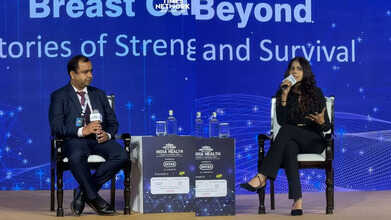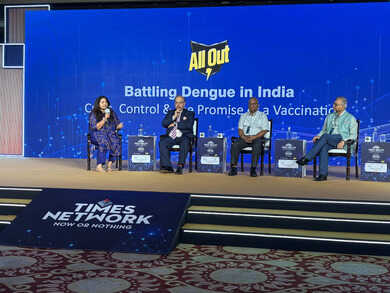- Health Conditions A-Z
- Health & Wellness
- Nutrition
- Fitness
- Health News
- Ayurveda
- Videos
- Medicine A-Z
- Parenting
- Web Stories
THIS Is The Age Your Body Starts Aging Faster: Research Pinpoints The Exact Time It Gets Worse

The human body doesn't age at the same rate everywhere. Right now, it's very likely that some parts of you are biologically older than others. This surprising idea comes from a recent study published in the science journal Cell. The main finding was that different organs don't follow the same schedule for aging.
Researchers discovered that certain body parts start showing signs of wear and tear like changes in their basic chemistry, long before other parts do. Tracking these varied timelines is a major goal for scientists, as it could eventually lead to new ways to slow down the aging process.
When Do Organs Start Aging Faster?
A study in the journal Cell analyzed proteins across different tissues to see when and how organs age. Researchers focused on proteins because they are fundamental to life, but a timeline of aging based on these proteins hadn't been mapped out before.
- Researchers studied 516 tissue samples from the hearts, lungs, liver, and several other organs of 76 deceased people.
- They found that while overall aging seems to pick up speed around age 50, many organs show major changes between 45 and 55.
- Surprisingly, organs like the aorta (the body's largest artery), spleen, and adrenal glands already showed noticeable protein changes by age 30.
- This "early and pronounced aging of the aorta" suggests that aging in blood vessels might be a major driver of how fast the whole body ages.
How Does Faster Aging Affect Our Health?
It’s difficult for doctors to apply these specific findings right now, but they do offer fascinating clues:
Silent Aging
Researchers still need to figure out the exact meaning of the protein changes they observed. Are these changes a bad sign of decline, a neutral side effect of getting older, or even a helpful response by the body to protect itself?
Disease Connection
The scientists found amyloid which is a protein famous for its role in Alzheimer’s disease, accumulating in other aging organs besides the brain. Even more exciting, they found certain proteins in the blood that seem to cause aging.
New Targets for Treatment
If future research can confirm this, it lays the groundwork for developing new therapies. In theory, drugs could be used to "clear those proteins" from the body, potentially reversing some aging processes.
How to Boost Longevity?
Although this new research holds great promise for the future, experts emphasize that for now, the best strategy for a long and healthy life is to stick to tried-and-true habits. These basic, proven healthy practices are your most powerful tools. They include:
- Eating a balanced diet.
- Staying physically active.
- Getting enough quality sleep.
- Learning to manage stress.
- Staying connected with your community.
The key takeaway from the new research is that you shouldn't put these habits off. Since aging, especially in key organs, starts earlier than you might realize, it's time to act now. Incorporating these healthy routines in your 20s and 30s is the best way you can try to "slow down this clock."
Times Network India Health Summit 2025: Chhavi Mittal And Dr Samant Gupta Discuss Breast Cancer And Beyond

The Times Network India Health Summit & Awards 2025 hosted a moving session on “Breast Cancer and Beyond: Stories of Strength, Science and Survival.” The conversation brought together actress and breast cancer survivor Chhavi Mittal and Dr. Sumant Gupta, Senior Consultant & Head of Medical Oncology, Hematology, BMT & Director at Metro Cancer Institute, and moderator Pooja Jain, Special Correspondent, Times Network.
Chhavi Mittal's Journey of Taking Charge
Chhavi Mittal opened the session with a candid reflection on her cancer journey. She shared that the first step was not immediate resilience, but acceptance. “Initially, I thought there must be a mistake. Maybe my lifestyle or diet had gone wrong, and if I corrected it, it would go away. But the moment I accepted the diagnosis, I could begin asking the right questions and take charge of my recovery,” she said.
She described herself today as “Chhavi 2.0, a stronger version of myself,” and stressed that every cancer journey is unique. “No two cancers are the same, and no two patients’ reasons are the same. What mattered for me was focusing on lifestyle, routine, and the steps I could control.”
Recurrence, Fear and Moving Forward After Fighting Cancer
Addressing one of the most pressing concerns, "recurrence," Dr. Sumant Gupta explained that about 10–15% of breast cancer patients face the risk of the disease returning. “The first five years are the most critical. After that, the chances reduce significantly, almost to the level of the general population,” he said. But for patients, he noted, living with the fear of recurrence is often harder than the treatment itself. “What helps is a combination of medical vigilance and lifestyle changes like maintaining a healthy weight, exercising regularly, eating a balanced diet, and avoiding alcohol and tobacco. Science today has evolved to preserve not just survival, but also the quality of life.”
Chhavi echoed this sentiment, adding that fear should not overshadow living. “I was fit, disciplined with my diet, I breastfed both my babies, and still, I got cancer. If it recurs, it recurs. I choose not to live under the weight of ‘what if.’ Faith has to be stronger than fear,” she said.
The Role of Caregivers
The discussion also highlighted the silent strength of caregivers. Chhavi shared how her husband supported her journey by giving her space to heal, physically and emotionally. “Sometimes the biggest strength is just allowing your partner to walk their own path and being there quietly,” she said. Dr. Gupta added, “Cancer does not happen to one person alone—it happens to the whole family. Caregivers play an equally important role, from ensuring treatments are followed to supporting the patient’s mental health.”
Shifts in Cancer Treatment
Dr. Gupta explained how oncology has transformed over the decades. “Earlier, treatments were aggressive and destructive. Today, we focus on conservation and holistic care. Surgeries are less invasive, chemotherapy side effects like nausea and hair loss are managed far better, and innovations like scalp cooling and precision drugs have changed patient experience,” he said. He underlined that the focus has shifted from just survival to quality of life, ensuring that patients emerge from treatment with dignity and confidence intact.
A Survivor’s Perspective
Closing the session, Chhavi left the audience with a powerful message. “Breast cancer was the best thing that happened to me. It jolted me out of my comfort zone and pushed me to grow. At one point I stopped comparing myself to who I was before cancer. I began taking one day at a time, and that changed everything. Today, I stand stronger, not in spite of cancer, but because of it.”
Times Network India Health Summit 2025: From Testing Challenges To Long-Term Risks, Experts Decode Battling Dengue

Today at Times Network India Health Summit and Awards 2025, a special panel discussion focused on “Battling Dengue in India: Crisis, Control & the Promise of a Vaccination”. The panel brought together three experts: Dr. Sanjeev Bagai, Chairman of Nephron Clinic, Senior Consultant Paediatrician & Nephrologist, Padma Shri awardee, Dr. K. Madan Gopal, Advisor and Head of Public Health Administration, National Health Systems Resource Centre and Dr Atul Kakar, Chairperson of the department of Internal medicine, Sir Ganga Ram Hospital. Together, they shared insights on how India can fight the growing dengue crisis.
Dengue Testing And Underreporting
Dr. Sanjeev Bagai began by explaining the challenges of testing. He noted that the NS1 antigen test, one of the most common diagnostic tools, does not turn positive until the end of the first day of infection. This often leads to false negatives if testing is done too early, adding to underreporting. He further talked about how many rural cases are never tested or are simply classified as “viral fever,” further skewing national numbers.
From a Seasonal Illness To A Perennial Problem
Dr. Madan Gopal stressed that dengue can no longer be considered a post-monsoon illness alone. “Over the decades, it has evolved from being a seasonal problem to becoming a perennial health threat,” he said, highlighting factors like rapid urbanisation, water stagnation, waste management failures, and climate change. “We need civic, community, and government surveillance working hand in hand to prevent mosquito breeding and control outbreaks,” he added.
Recognising The Dengue Symptoms
Dr Atul Kakar agreed that public awareness of warning symptoms is critical. Severe headaches, pain behind the eyes, back pain, and high-grade fevers should alert both patients and healthcare providers. Dr. Bagai explained that the infection passes through four phases, acute febrile, critical, plateau, and recovery. Importantly, he warned that a fall in fever does not signal recovery. Dr Bagai told us, “Instead, this is often when platelet counts dip, and complications can arise.”
Managing the Patient Burden
On hospital preparedness, Dr. Madan Gopal underlined that 70–80% of dengue cases can be managed at home with proper hydration and monitoring. He emphasised building capacity in both public and private healthcare sectors to identify warning signs early and prevent unnecessary hospital admissions that overwhelm facilities.
Dangers of Self-Medication During Dengue
Dr. Bagai strongly cautioned against relying on home remedies or inappropriate drugs. “Yoga, papaya leaf juice, or herbal concoctions do not cure dengue,” he said. He also warned against taking aspirin, ibuprofen, or antibiotics, as these can worsen bleeding risks and damage the liver or kidneys. The only safe medicine for managing fever, he stressed, is paracetamol along with adequate fluids.
Long Dengue
A critical takeaway from Dr. Bagai was that dengue does not end with the fever. He pointed to new research showing long-term complications, including higher risks of cardiac issues, autoimmune conditions, kidney damage, and neurological problems—sometimes lasting for months after infection. This “long dengue syndrome,” he said, is an emerging challenge that must be factored into health planning.
Dengue Vaccine
When asked about the future of a dengue vaccine, Dr Bagai was cautious. He explained that while early vaccine trials have taken place, the long-term efficacy is poor, with protection falling sharply after four to five years. “Some vaccines work only in the early stages of infection and fail against later serotypes. Others carry the risk of worsening the disease due to the body’s unpredictable immune response,” he said.
Dr Bagai added that dengue’s overlap with other viral exposures, including influenza, COVID-19, and Zika, complicates vaccine development. “The worst thing you can do is give a vaccine that ends up triggering a more severe infection. Some global studies have shown exactly that an increase in hospitalisations among vaccinated individuals,” he warned.
Instead of banking on a vaccine anytime soon, Dr. Bagai stressed that prevention must remain the priority. “The safest and most effective protection is to keep mosquitoes out of your homes, manage water storage, and prevent breeding grounds. Vaccines for dengue are still a far, far distance away,” he said.
Dr. K. Madan Gopal agreed that while research continues, community action, civic surveillance, and strong preventive measures remain India’s best defence in the near term.
The panel concluded that India’s fight against dengue requires:
- Early testing and accurate diagnosis to reduce underreporting.
- Mass public awareness campaigns on prevention and warning signs.
- Stronger civic action to control mosquito breeding.
- Responsible treatment with hydration, paracetamol, and medical supervision.
- Focus on vaccination research, given the presence of four dengue serotypes and risks of repeat infections.
Dr. Bagai summed it up: “Dengue is not just a seasonal fever anymore. It is a national health crisis that demands prevention, awareness, and scientific management, not myths or shortcuts.”
The partners of the Times Network India Health Summit are:
Powered by- INTAS
Co-powered by- Novartis and All out
knowledge partner- MGR University
Supporting partner- FIT INDIA
Strategic alliance partner- OneXtel
Wealth Partner- Nuvama
Outdoor partner- Heights
Do We Take Better Care Of Our Cars Than Ourselves? Survey Shows 44% People Never Got Their Cholesterol Checked

(Credit-Canva)
A surprising number of people in the UK are giving more attention to their cars than to their own health, even though heart disease is the biggest threat to life in the country.
New research revealed that for many, booking a car in for its mandatory annual check-up (the MOT) is a routine priority. Yet, when it comes to vital check-ups for their own health, like a simple cholesterol test, a lot of people fall short. This is particularly worrying because heart disease remains the single leading cause of death in the UK.
The research suggests that we take the warning lights on a car dashboard more seriously than the potential warning signs—or the need for preventative checks—in our own bodies, putting comfort and convenience ahead of potentially life-saving health screenings.
Ignoring Warning Health Signs
The survey, commissioned by supplement brand Healthspan showed a startling gap between how Britons treat their vehicles and their health.
- Nearly two-thirds (66%) of people aged 35 to 54 faithfully book their cars in for an annual MOT (a yearly safety and emissions check).
- However, fewer than half of the same group have had their cholesterol checked in the last five years.
- Overall, almost half of the 2,000 people surveyed admitted they have never had their cholesterol checked at all.
Experts pointed out that people wouldn't ignore a flashing warning light on their car's dashboard, yet they often ignore the warning signs from their own bodies. He stressed that midlife is the most important time for checks on blood pressure and cholesterol, even for those who feel perfectly fine.
What Health Concerns Matter More To People?
The survey revealed that people's worries often focus more on appearance and immediate concerns than on serious health risks like heart disease.
- Women's top worries included wrinkles and weight gain around the middle, ranking higher than heart health.
- Men's primary concerns were erectile dysfunction and having a "beer belly," which they worried about more than heart disease.
- Surprisingly, one in five Britons admitted that loneliness worried them more than being ill.
Why Does Cholesterol Matter?
Cholesterol is often called the "silent killer." While it's necessary for things like hormones and cell membranes, too much of the "bad" LDL cholesterol can build up in your arteries. This dangerous build-up significantly increases your risk of having a heart attack or stroke.
The shocking truth is that you can be slim, active, and appear healthy, but still have high cholesterol. A nutritionist involved with the study was diagnosed with high cholesterol this year despite being fit and health-conscious.
One cannot assume they’re fine just because they look healthy. Knowing your numbers matters.
So, what is the solution for it? Managing cholesterol isn't just about cutting things out of your diet; it's about adding things in. Foods like oats, beans, nuts, olive oil, and plant sterols can actively help lower your cholesterol levels.
What Test Do You Need To Know Cholesterol Numbers?
According to the Centers for Disease Control and Prevention, a cholesterol test, also called a screening, is a very simple blood test that checks the different types of fat, or lipids, in your blood. It gives your doctor a complete picture of your heart health risk.
LDL ("Bad") Cholesterol
Too much LDL can cause a sticky substance called plaque to build up inside your arteries, making them narrow. This buildup greatly increases your risk of having a heart attack or stroke.
HDL ("Good") Cholesterol
HDL actually helps your body get rid of the bad cholesterol. Having higher levels of HDL is protective and helps lower your risk of heart disease and stroke.
Triglycerides
This is a type of fat your body uses for energy. High levels of triglycerides, especially when combined with low "good" HDL or high "bad" LDL, can also increase your risk for a heart attack and stroke.
Total Cholesterol
This is simply the total amount of cholesterol in your blood. This number is a summary of all the fats in your blood, calculated from your HDL, LDL, and triglyceride results.
© 2024 Bennett, Coleman & Company Limited

